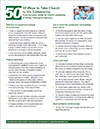Churches can no longer open their doors and expect that people will come in. Effective congregations go into the world to encounter those in need of the gospel. These 50 Ways provide tips on reaching beyond the walls of your church with worship, community events, ministries, and service.
Embrace an expansive concept of community
- Learn to regard your community as an extension of your congregation. A church’s mission field goes beyond its membership to include all the people God calls it to serve. You are connected to individuals who never set foot in your building.
- Know that what’s happening within the church — preaching, worship, music, Bible study — is no longer enough to attract people in an age when church attendance is no longer a cultural expectation.
- Don’t sit in your church building waiting for people to come. Be prepared to meet people where they are.
Prepare spiritually
- Acknowledge the synergy between the Great Commandment in Matthew 22 (love your neighbor as yourself) and the Great Commission in Matthew 28 (go and make disciples). Evangelistic outreach expresses our love of others.
- Remember that Jesus primarily engaged people through everyday encounters, rather than in the Temple or synagogues. He fed people, met their everyday needs, and enjoyed the fellowship of others.
- Express love and compassion for your community in big and small ways. Avoid judgmentalism.
- Pray regularly for your neighbors and lift up community concerns.
- Attend to the faith formation of existing members. Willingness to share faith and reach out to others develops as one grows in faith and discipleship.
- Prepare spiritually for the transformation that creative, risk-taking outreach will bring.
Get to know the community surrounding your church
- Review demographic data from public, private, and denominational sources, but don’t assume that statistics alone will tell the whole story.
- Get out in your neighborhood. Walk the streets. Map the area, and record your observations. Note how the community is changing.
- Assess community needs and assets. What are the needs of your context? Who are your neighbors, and how can you serve them?
- Be attuned to where God is already at work in your community.
Listen and learn
- Know that ministries that truly bless a community often arise out of conversations where you listen for the hopes and dreams of people in your community.
- Interview residents of the community. Sit in a park, diner, or coffee house. Ask simply, “What are your challenges, hopes, longings and dreams?”
- Get to know the major public officials. They are people with tremendous influence. They need to know of your church’s commitment to the community.
- Involve many people from your church in this work. Hold one another accountable to the tasks of engaging and learning from others.
- Discern clusters of issues and concerns that arise from these conversations. Ask what issues, suffering, injustices, or brokenness might you address.
Build authentic relationships
- Strive for meaningful engagement with others, not superficial gestures.
- Make sure you are reaching out to people for the right reasons. If your motive is simply to get them to come to church, people will see right through to it.
- Maintain appropriate boundaries, and respect all with whom you engage.
- Collaborate with others who are also passionate about the community. Don’t reinvent the wheel if you can partner with someone else serving the community.
Turn your existing ministries outward
- Challenge each church group with an inside focus to find a way to become involved with the community outside the church. A choir might sing at a nursing home, or trustees could sponsor a neighborhood clean-up.
- Extend recruiting and advertising for church groups and events to audiences beyond your congregation. For example, recruit for choir members in a local paper or community list serve.
- Build relationships with those taking part in existing programs that serve the community, such as ESL classes, food pantry or clothes bank users, daycare families, etc.
Reach out through community events
- Plan “bridge events” designed explicitly to draw people from the community by providing for them something they need or enjoy — block parties, free concerts, seasonal events, parenting classes, sports camps, or school supply giveaways, etc. Source: Get Their Name by Bob Farr, Doug Anderson, and Kay Kotan (Abingdon Press, 2013)
- Hold these events off church property or outside the church walls in venues where people feel comfortable and naturally congregate.
- Get the word out through a well-planned publicity campaign.
- Encourage church members to invite their friends and neighbors. It is less threatening for them to invite someone to a community event than to worship.
- Avoid explicitly religious themes: no preaching, prayers, pressure, or financial appeals that might turn people off or reinforce negative stereotypes about church.
- Remember, the event itself is not the purpose. The purpose is to meet people where they are and build relationships. Mingle. Get to know people.
- Have a well-trained hospitality team. Make sure guests are enjoying themselves and know their attendance is appreciated.
- Gathering people’s names and information about them will permit follow up to those for whom it is appropriate.
- Invite those who attend community events to another event — sometimes called a “hand off event” — planned to draw them into a deeper relationship.
Extend your congregation’s spiritual presence beyond church walls
- Recognize that many “unchurched” people are spiritually inclined but apprehensive about attending church because they feel unwelcome, distrust institutions, or have been hurt in the past.
- Pay attention to the heightened receptiveness to spiritual engagement around religious holidays such as Easter and Christmas.
- Offer offsite worship services on special days, such as Christmas Eve, Palm Sunday, and Easter. Select familiar venues where people feel comfortable — parks, restaurants, parking lots, coffee houses.
- Offer imposition of ashes on Ash Wednesday in public places.
- Partner with other institutions (such as nursing homes, hospitals, or prisons) or commercial establishments (restaurants, bars, shopping centers, or sports facilities) to offer worship services to their constituents or clientele on special days.
- Plan creative outdoor events, such as live nativities or “blessing of the animals” services, to help make your church visibly present to the community in creative ways.
- Hold your Vacation Bible School in a local park or recreation center. Canvas nearby neighborhoods to invite families.
- Reach out to local media. Community outreach is often newsworthy, and reporters are often looking for religiously themed stories around the holidays.
Connect spiritual outreach to community service
- Acknowledge that many served through feeding and clothing ministries, justice ministries, weekday children’s services, and other ministries of community service have no other connections with our churches.
- Ask if these ministries inadvertently convey an “us and them” attitude or communicate that “you are not worthy of joining us.”
- Identify aspects of church life, such as characteristics of the building or how people dress, that may make some feel unwelcome. Are there alternatives that may reduce barriers for some to enter?
- Treat everyone as a person of dignity who deserves respect.
- Extend genuine hospitality to those you serve.
- Focus first on building relationships of understanding and trust.
- Consider adding a spiritual or discipleship element to community service activities but without any sense of expectation or requirement. For example, have a service or study following ESL classes for any interested.
- Seek to conduct each activity in a way that connects people to God and the church.
Contributors: Robert Crossman, Ann A. Michel, Kim Mitchel, and Lovett H. Weems, Jr.
Download a PDF of this page to share with others.

 Lewis Center video tool kit resource
Lewis Center video tool kit resource
Reach New Disciples with “Taking Church to the Community”
Explore strategies your congregation can use to reach beyond its walls with worship, community events, ministries, and service. The Taking Church to the Community Tool Kit features engaging videos, presentations, and supplemental materials and is designed for both self study and for use with groups in your church. Learn more and watch introductory videos now.






